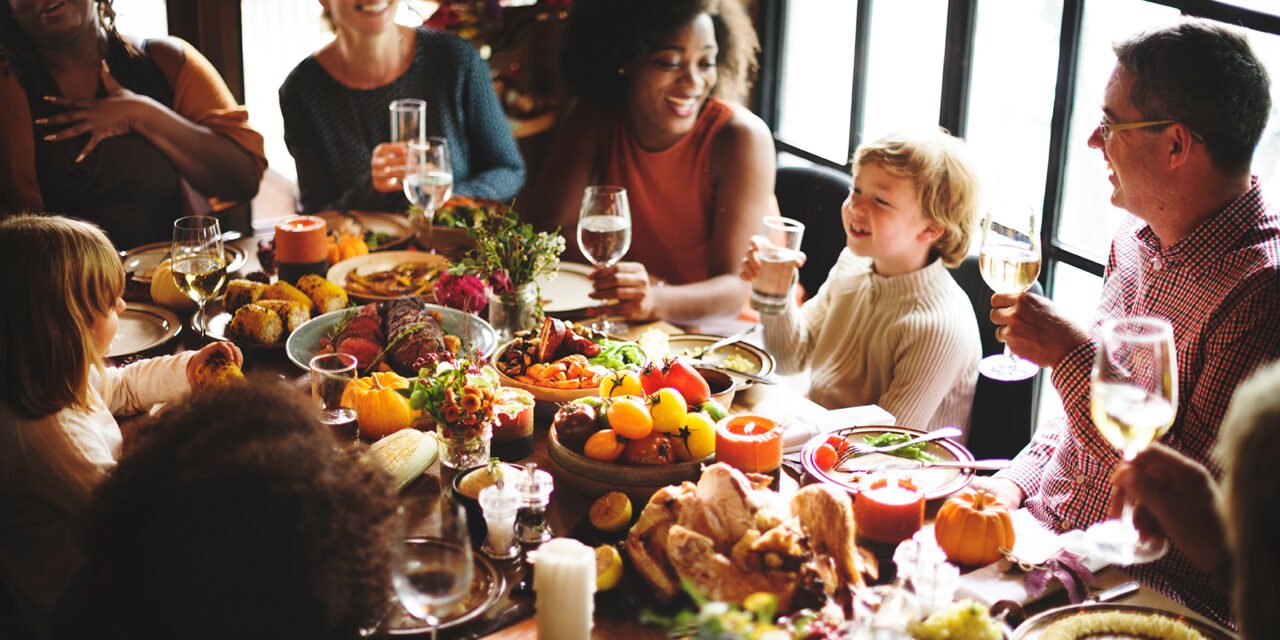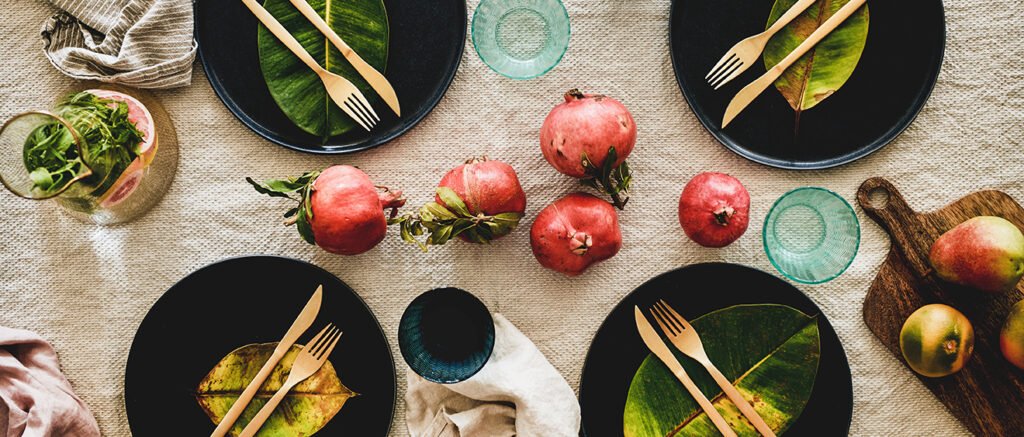Celebrating Thanksgiving is a time of gratitude, family, and feasting. It’s also a time when we can make conscious choices to celebrate in an eco-friendly way. By incorporating sustainable practices into Thanksgiving traditions, we can reduce waste, conserve resources, and minimize our impact on the environment. Here is our ultimate guide to hosting an eco-friendly Thanksgiving celebration.
1. Choose Local and Organic
Support local farmers and reduce the carbon footprint of your meal by choosing locally sourced, organic ingredients. Visit your nearest farmer’s market or join a community-supported agriculture (CSA) program to find fresh, seasonal produce. Choose an organic turkey or consider a plant-based alternative for a more sustainable main course. Here are five additional reasons to choose local, organically grown foods and tips to make your choices easier.
Here are 5 reasons to choose local and organic while Celebrating Thanksgiving.
When choosing the food we eat, it’s important to consider the impact our choices have on our health and the environment. One way to make a positive difference is by buying organic or locally grown food. Here are five compelling reasons:
1. Health Benefits
Organic foods are without the use of synthetic pesticides, herbicides, or genetically modified organisms (GMOs). It is also free from artificial additives and preservatives. By choosing organic food, you can reduce your exposure to harmful chemicals and enjoy foods that are more nutritious and flavorful.
2. Environmental Conservation
Organic farming practices promote soil health, biodiversity, and water conservation. By supporting organic agriculture, you are helping to protect the environment, preserve natural resources, and reduce pollution.
3. Support Local Economy
Buying locally grown food supports small-scale farmers and local businesses. It helps create jobs, strengthens the local economy, and fosters a sense of community. By choosing to buy from farmers’ markets or joining a Community Supported Agriculture (CSA) program, you can directly support local food producers.
4. Seasonal Eating
Locally grown foods are harvested at their peak for ripeness and flavor. By eating seasonally, you can enjoy a variety of fresh and delicious produce throughout the year. It also reduces the need for long-distance transportation, which helps lower greenhouse gas emissions.
5. Food Safety
Organic and locally grown food undergoes rigorous testing and certification processes. This ensures that it meets strict quality and safety standards. By buying organic or locally grown food, you can have peace of mind knowing that you are consuming food that is free from harmful contaminants.
5 Tips on Choosing Organic or Locally Grown Food
Choosing between organic and locally grown food can be a tough decision. Both options have their own benefits, and it ultimately depends on your personal preferences and values. If you’re looking to make more conscious choices about the food you consume, here are 5 tips to help you make the best decision during the holiday season:
1. Research the Benefits:
Take the time to understand the benefits of both organic and locally grown food. Organic food means without the use of synthetic pesticides or fertilizers, while locally grown food is often fresher and supports local farmers.
Related: Is it Better to Buy Locally or Organically?
2 . Consider Your Budget
Organic food is typically more expensive than conventionally grown food. If budget is a concern, prioritize certain organic items, such as fruits and vegetables that have higher pesticide residue.
Related: Why Organic Foods Is More Expensive Than Conventional Foods?
3. Visit Local Farmers’ Markets
Local farmers’ markets are a great place to find fresh, locally grown produce. Not only can you support local farmers, but you can also ask them about their farming practices to ensure they align with your values.
Related: Find a Local Farmers’ Market in Your Area
4. Read Labels
When shopping for organic food, look for the USDA Organic seal. This ensures that a reputable organization has certified the product. For locally grown food, look for labels that show the farm or region where the food is grown.
Related: The Basics of Nutrition Food Label
5. Consider Seasonality
Locally grown food is often more seasonal, meaning you may not find certain items year round. Embrace the changing seasons and enjoy the variety of produce that is available during different times of the year, especially during the Thanksgiving holiday.
Related: A Beginner’s Guide to Seasonal Eating
Ultimately, the choice between organic and locally grown food is personal. By doing your research, considering your budget, visiting local farmers’ markets, and reading labels, you can make conscious choices when choosing the foods to prepare. Simply embracing seasonality, you can make informed decisions that align with your values and preferences. Whether you choose organic, locally grown, or a combination of both, you can feel good about supporting sustainable and healthy food choices during the thanksgiving holiday.
2. Reduce Food Waste When Celebrating Thanksgiving
Thanksgiving often means leftovers, but it’s important to minimize food waste. Plan your menu carefully and only buy what you need. Thanksgiving season is a great time to share food with others because it’s the spirit of thanksgiving and no one should be without food at this time of the year.
Why we should reduce food waste during Thanksgiving?
As mentioned above, Thanksgiving is a time for gratitude, family, and, of course, delicious food. But it can also be a time of excess. From uneaten leftovers to disposable decorations (more on decorations below) Thanksgiving holidays can take a toll on the environment. However, with a few conscious changes, we can make our Thanksgiving celebrations more sustainable, while reducing waste.
One of the biggest sources of waste during Thanksgiving is food. To minimize food waste, plan your menu carefully and only buy what you need. Consider donating excess food to local food banks or composting leftovers.
Another way to reduce waste is to use reusable plates, cups, and utensils instead of disposable ones. If you must use disposable items, choose compostable or biodegradable options.
Decorations can also contribute to waste. Instead of buying new decorations every year, get creative and make your own using natural materials or items you already have. Also, if you must buy new decorations, consider buying reusable ones and have a system in place to preserve your decorations for the years to come.
By taking these small steps, we can have a more sustainable Thanksgiving that not only reduces waste but also sets a positive example for future generations. Let’s make this holiday season a time of gratitude for both our loved ones and the planet we call home.
5 Tips for Reducing Waste During Thanksgiving
Thanksgiving is a time for gratitude, family, and, of course, a delicious feast. However, it’s also a time when a significant amount of waste is generated. Here are five tips for reducing the amount of waste used during this annual celebration.
1. Plan your portions
One of the biggest culprits of Thanksgiving waste is food that goes uneaten. Before you start cooking, make a detailed plan of the dishes you’ll be serving and estimate the portions needed. This will help you avoid overcooking and ensure that leftovers are minimized.
Resource: Download Your Free Thanksgiving Planner
2. Use reusable tableware
Avoid using disposable plates, cups, and cutlery. Instead, opt for reusable tableware. If you don’t have enough at home, consider borrowing from friends or family or renting from a local party supply store.
Resource: Eco-friendly table wear
3. Compost food scraps
Instead of throwing food scraps in the trash, start a compost pile in your backyard or find a local composting facility. This will divert organic waste from the landfill and create nutrient-rich soil for your garden.
Resource: Guide for composting at home; Finding a composting Facility
4. Serve tap water
Instead of offering bottled water or sugary drinks, serve filtered tap water in reusable glasses. If you want to add some flavor, infuse the water with fruits or herbs for a refreshing twist.
Resource: How to filter tap water
5. Donate leftovers
If you find yourself with an abundance of leftovers, don’t believe you or your family can eat it all in the days to come. Let’s be realistic. Leftovers are only appealing a day or two later. Consider donating most of your uneaten foods to a local food bank or shelter.
Many organizations accept cooked food, and this can help reduce food waste while providing a meal to those in need.
By following these tips, you can enjoy a delicious Thanksgiving feast while also reducing waste and making a positive impact on the environment. Let’s make this holiday season one that is both joyful and sustainable!
3. Celebrating Thanksgiving And Ditching Disposable Dinnerware
Avoid single-use plastics and disposable dinnerware by using reusable plates, glasses, and utensils. If you don’t have enough for all your guests, consider renting or borrowing from friends and family. If using disposable items is unavoidable, choose biodegradable or compostable options.
Why We Should Ditch Disposable Ware During Thanksgiving
Thanksgiving is a time for gratitude, family, and delicious food. However, it’s also a time when we generate a significant amount of waste, especially disposable ware. From paper plates to plastic cutlery, these single-use items may be convenient, but they come at a high cost to the environment.
One of the main reasons we should ditch disposable ware during Thanksgiving is to reduce our carbon footprint. The production and disposal of these items contribute to greenhouse gas emissions and pollution. By using reusable plates, glasses, and utensils, we can significantly decrease the amount of waste that ends up in landfills.
Another important reason to avoid disposable ware is the impact it has on wildlife. Many animals mistake plastic for food and end up ingesting it, causing serious harm and even death. By opting for reusable alternatives, we can help protect our natural ecosystems and the creatures that inhabit them.
Furthermore, using disposable ware is not only harmful to the environment but also costly in the long run. Investing in reusable dinnerware may require a small upfront investment, but it will save you money. You won’t need to repurchase disposable items, and you’ll be contributing to a more sustainable future.
So, how can we ditch disposable ware during Thanksgiving? Start by using your regular dinnerware or invest in reusable options made from sustainable materials such as bamboo or stainless steel. Encourage your guests to bring their own reusable containers for leftovers, reducing the need for disposable plastic wrap or aluminum foil.
By making the switch to reusable ware, we can make a big difference in preserving our planet for future generations. This Thanksgiving, let’s show our gratitude not only for the food on our tables but also for the Earth that sustains us.
5 Tips for Using Sustainable Dinnerware During Thanksgiving
Thanksgiving is a time for gathering with loved ones and enjoying a delicious meal together. However, it’s also a time when a lot of waste is generated, especially with single-use dinnerware. This year, why not make your Thanksgiving celebration more sustainable by using eco-friendly dinnerware? Here are 5 tips to help you do just that:
1. Opt for reusable dinnerware
Instead of using disposable plates and cutlery, consider investing in reusable dinnerware made from sustainable materials like bamboo or stainless steel. They not only look stylish but also reduce waste.
2. Choose compostable options
If you prefer disposable dinnerware, opt for compostable options made from materials like bagasse or palm leaf. These can be easily composted after use, reducing the environmental impact.
3. Rent dinnerware
If you’re hosting a large gathering and don’t have enough reusable dinnerware, consider renting them instead. Many rental companies offer eco-friendly options, saving you money and reducing waste.
4. Encourage guests to bring their own
To further reduce waste, encourage your guests to bring their own reusable dinnerware. This not only saves resources but also adds a personal touch to the gathering.
5. Properly dispose of waste
After the meal, dispose of waste properly. Separate compostable items from recyclables and non-recyclables. This ensures that waste is disposed of environmentally responsibly.
By following these tips, you can enjoy a sustainable Thanksgiving celebration without compromising on style or convenience. Let’s make this holiday season a time for gratitude towards the planet as well!
Resource: Why Not to Use Disposable Dinnerware
4. Decorate Naturally When Celebrating Thanksgiving
Instead of buying plastic decorations, opt for natural elements like pinecones, leaves, and branches. Use reusable cloth napkins and tablecloths instead of disposable ones. If you want to add a festive touch, consider using LED lights, which are more energy-efficient than traditional incandescent bulbs.
Why Decorating Naturally During Thanksgiving is a Great Idea
Thanksgiving is a time to gather with loved ones, express gratitude, and create a warm and inviting atmosphere. One way to enhance the festive spirit is by decorating naturally. Not only does decorating with natural elements bring a touch of beauty to your home, but it also has many benefits.
First, decorating naturally is environmentally friendly. By using items such as pinecones, leaves, and branches, you are opting for sustainable materials that can be easily composted or reused. This reduces waste and minimizes your carbon footprint.
Second, natural decorations add a sense of warmth and authenticity to your Thanksgiving celebration. The earthy colors and textures of natural elements create a cozy ambiance that cannot be replicated by artificial decor. It evokes a sense of connection to nature and the changing seasons.
Also, decorating naturally allows you to incorporate the bountiful harvest of the season. Displaying colorful gourds, pumpkins, and autumnal fruits not only adds visual interest but also celebrates the abundance of nature’s gifts.
Natural decorations can be a fun and engaging activity for the whole family. Take a nature walk to collect fallen leaves, acorns, and twigs. Involve your children in creating centerpieces or wreaths using these natural treasures. It fosters creativity and encourages appreciation for the natural world.
In conclusion, decorating naturally during Thanksgiving is a wonderful way to celebrate the season while being mindful of the environment. It adds a unique charm to your home, connects you to nature, and allows you to showcase the beauty of the harvest. So this year, consider embracing natural decor and create a Thanksgiving atmosphere that is both stunning and sustainable.
5 Tips for Decorating Naturally for Thanksgiving
Thanksgiving is a time to gather with loved ones and give thanks for all that we have. It’s also a time to decorate our homes and create a warm and inviting atmosphere for our guests. If you are someone who loves the beauty of nature and wants to bring that into your Thanksgiving decor, here are five tips for decorating naturally this holiday season.
1. Use Seasonal Foliage
Instead of relying on store-bought decorations, why not bring the beauty of the outdoors inside? Gather fallen leaves, branches, and pinecones from your backyard or local park to create stunning centerpieces and wreaths. Not only will this save you money, but it will also add a touch of authenticity to your Thanksgiving decor.
2. Incorporate Natural Elements
Consider incorporating natural elements such as pumpkins, gourds, and corn husks into your Thanksgiving decor. These items can be easily found at local farmers’ markets or grocery stores and can be used in a variety of ways, from table centerpieces to mantel displays.
3. Opt for Earthy Colors
When choosing your color palette for Thanksgiving, opt for earthy tones such as browns, oranges, and yellows. These colors mimic the changing leaves and create a warm and cozy atmosphere in your home. You can incorporate these colors through your table linens, throw pillows, and even wall art.
4. Embrace Natural Lighting
Instead of relying on artificial lighting, embrace natural lighting in your Thanksgiving decor. Open your curtains and let the sunlight fill your space. If you’re hosting an evening gathering, consider using candles or string lights to create a soft and intimate ambiance. Read more about natural lighting below.
5. DIY Natural Decorations
Get creative and make your own natural decorations for Thanksgiving. Consider making a garland out of dried orange slices and cinnamon sticks or create a rustic centerpiece using a wooden crate filled with acorns and twigs. Not only will these DIY decorations add a personal touch to your home, but they will also be a fun activity to do with your family.
By following these five tips, you can create a beautiful and natural Thanksgiving decor that will impress your guests and make them feel right at home. Remember, Thanksgiving is not just about the food, but also about the atmosphere and the memories you create with your loved ones.
Related: How to Set a Thanksgiving Table In Warm Fall Colors
5. Save Energy While Celebrating Thanksgiving
Be mindful of your energy consumption during Thanksgiving. Cook multiple dishes at the same time to save energy. Use your oven’s self-cleaning feature after the meal when it’s already hot. Turn off unnecessary lights and unplug electronic devices when not in use. If weather permits, open windows instead of using air conditioning or heating.
Why You Should Save Energy During Thanksgiving
Thanksgiving is a time for gathering with loved ones, expressing gratitude, and enjoying delicious food. However, it’s also a time when energy usage spikes. From cooking a feast to hosting guests, the holiday season can put a strain on both your wallet and the environment. That’s why it’s important to consider ways to save energy during Thanksgiving.
One of the easiest ways to reduce energy consumption is by using energy-efficient cooking appliances. Instead of using the oven for every dish, consider using a slow cooker, microwave, or toaster oven for smaller items. These appliances use less energy and can help you save on your electricity bill.
Another way to save energy is by being mindful of your heating and cooling usage. With a house full of guests, it’s easy to crank up the heat or blast the air conditioning. However, adjusting the thermostat by just a few degrees can make a significant difference in energy consumption.
Also, consider using natural lighting during the day instead of relying solely on artificial lights. Open your curtains or blinds to let in the sunlight, which not only saves energy but also creates a warm and inviting atmosphere.
Don’t forget to unplug any unnecessary electronics or appliances when they’re not in use. Even when turned off, many devices still draw power, known as phantom energy. By unplugging these items, you can reduce standby power and save energy.
5 Tips for Saving Energy During Thanksgiving
Thanksgiving is a time for gathering with loved ones, expressing gratitude and, of course, enjoying a delicious feast. However, the holiday season can also be a time of increased energy consumption. From cooking to hosting guests, the energy usage can quickly add up. To help you save energy and reduce your carbon footprint this Thanksgiving, here are five tips:
1. Optimize Your Oven
Thanksgiving dinner often revolves around the oven, but you can still save energy while cooking your turkey and sides. Use the oven’s convection setting, which circulates hot air and reduces cooking time. Also, avoid opening the oven door frequently as it can cause heat loss and increase cooking time.
Related: 8 Ways to Make Your Oven More Energy Efficient
2. Use Energy-Efficient Appliances
If you have energy-efficient appliances, use them to prepare your Thanksgiving meal. These appliances use less energy while still delivering excellent performance. From the dishwasher to the stovetop, using energy-efficient appliances can help you save energy and money.
Related: Are Energy Efficient Appliance Worth It?
3. Embrace Natural Lighting
During the day, take advantage of natural lighting by opening curtains and blinds. This will allow sunlight to illuminate your home, reducing the need for artificial lighting. Not only will this save energy, but it will also create a warm and inviting atmosphere for your guests.
Related: What Are the Benefits of Natural Lighting?
4. Minimize Phantom Energy
Phantom energy, also known as standby power, refers to the energy consumed by electronic devices when they are turned off but still plugged in. To minimize phantom energy, unplug devices that are not in use, such as phone chargers, kitchen appliances, and entertainment systems.
Related: What is Phantom Power and How to Track It
5. Plan Your Meal Wisely
Before you cook, plan your meal to avoid unnecessary energy usage. Consider using the stovetop and microwave for smaller dishes instead of the oven. Also, try to cook multiple dishes at once to maximize oven usage and reduce overall cooking time.
Related: Download our free Thanksgiving Planner, which includes a meal planner
Incorporating these five tips, in your celebration, you can enjoy a festive and energy-efficient Thanksgiving. Not only will you save energy and reduce your carbon footprint, but you will also save money on your utility bills. So, this holiday season, let’s give thanks for the Earth by being mindful of our energy consumption.
Summary
Thanksgiving is a time for gratitude, family, and delicious food. But it’s also an opportunity to reflect on our impact on the environment and make choices that promote sustainability and conservation. Here are a few reasons having a positive impact on the environment is so important when celebrating Thanksgiving.
By following these eco-friendly tips, you can make a positive impact on the environment while still enjoying a memorable Thanksgiving with your loved ones. Let’s give thanks for the Earth and strive for a sustainable future.

















